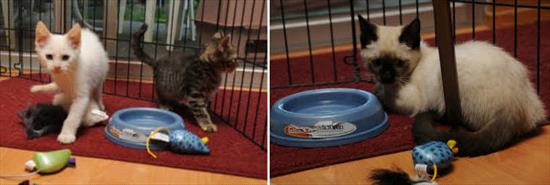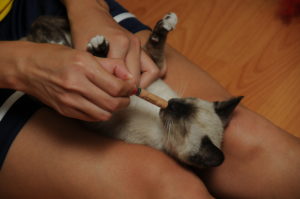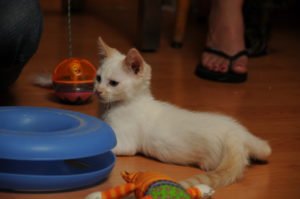It’s kitty season – meaning, as usual, there are tons of pregnant female cats and young kittens being relinquished to shelters. Most will ultimately be euthanized but some will be fostered and find good homes. While most foster kitten raisers focus on keeping the kittens medically healthy, the most important factor for keeping kittens in their new home is training and socializing them well. We want them to be outgoing, friendly, and social with many different people and in many different environments. We also want them to learn how to play with toys and learn basic exercises such as “sit” and “come when called.”
Here are my training assistant Melissa’s 6-week old foster kittens.
The tortie and the orange/white girls are outgoing. The seal point and white kittens are more shy/fearful. They’ve already gotten more comfortable in the last few days because Melissa has handled them a lot and had visitors come play with them. But you can see from their posture that they are less active and more tentative in the new environment. Overall, they aren’t as interested in exploring the environment or checking out the toys and they would prefer to just huddle in one spot. They are comfortable enough so that they will eat tuna in the new environment, which helps them to associate the environment with good things. The white kitten quickly becomes interested in the toys and consequently is feeling more comfortable in the new environment.
It’s critical that kittens have good experiences in many new environments with many new people and animals so that, later in life, they don’t consider the new environments, people, and animals to be stressors. Their prime time for socialization is between 3 weeks to 3 months of age. As soon as you get a kitten, the clock is ticking and it’s a race to get enough socialization in so that you will have a well-adapted cat. Those who lack good socialization may hide from visitors, fear other pets, and adapt very slowly to new environments. And they can be fearful and aggressive at the veterinary hospital. They also become easily stressed by little changes in the environment. BTW: when cats get stressed they spray or urinate outside the box–which is a major cause of relinquishment and euthanasia.
Kittens should be taken in carriers to various kitten-safe locations such as just for a car ride, to a friend’s house, or on errands to locations that are cat free (or with cats that have been vaccinated). For more information on kitten socialization and its importance read chapters 1, 18, 20 and watch the accompanying DVD of “Low Stress Handling,® Restraint, and Behavior Modification of Dogs and Cats,” available in our online store, or, through our Low Stress Handling® online University. Stay tuned for more photos of these cute kittens.
These outgoing kittens love to play and explore in this new environment.
This seal-point screamed and hissed the first time she was held for a toenail trim. Now she happily holds still when handled because she’s getting treats simultaneously. Soon Melissa will be able to trim her nails while the kittens sits patiently.
Here’s the white kitten at first. He tentatively just lays in place. He’s not interested in checking out the food -dispensing ball. But he did eat the tuna that’s laying around his feet.

Now he’s interested in the toy and having a good time. Positive experiences like this will train him to be more comfortable in new environments.








